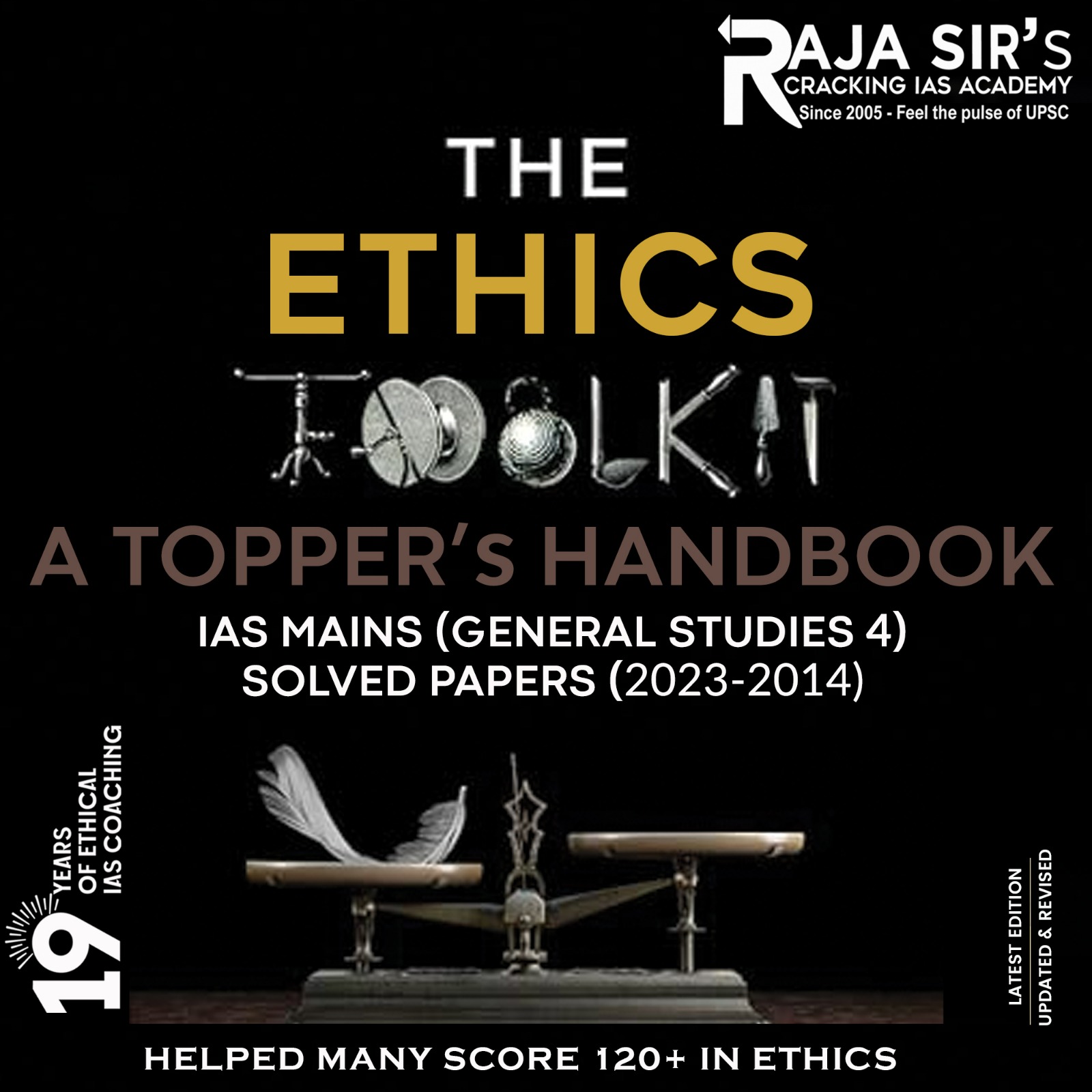- Home
- Prelims
- Mains
- Current Affairs
- Study Materials
- Test Series
Hit List Questions 51-PPP 100 PRELIMS 2024 - 69
Questions & Explanations:
|
1. |
I. In moist weather, the coefficient of friction increases, disadvantaging the bowler in a cricket match. II. When the air temperature drops, sunlight causes less turbulence in the air above the pitch, giving bowlers more control. Which of the above statements is/are true?. (a) Only I (b) Only II (c) Both I & II (d) Neither I nor II
|
|
2. |
The cosmological constant is a term introduced by (a) Edwin Hubble (b) Albert Einstein (c) Heisenberg (d) George Higgs
|
|
3. |
Which of the following is/are true? 1. When light travels from glass to air it passes through partially while the rest is reflected away. 2. Total Internal Reflection, is the basis of guiding light across long distances without a significant loss of optical power. (a) 1 only (b) 2 only (c) Both 1 and 2 (d) Neither 1 nor 2
|
|
4. |
1. It is made of Carbon nanotubes. 2. It is the world''s darkest material. 3. Barium sulphate imparts the darkness to it. 4. It is chemically neutral. Which of these is/are true regarding vantablack?. (a) 1, 2. 3 (b) 1, 3. 4 (c) 2, 3. 4 (d) 1, 2. 4
|
|
5. |
I. They are insects. II. They are the closest relatives of the hyrax. Which of the above statements is/are true w.r.t. Manatees?. (a) Only I (b) Only II (c) Both I & II (d) Neither I nor II
|
|
6. |
A Geosynchronous satellite continuously active in its orbit due to centripetal force which is obtained by (a) The rocket engine that propelled the satellite. (b) The gravitational force on the satellite by the earth. (c) The gravitational force on the satellite by the sun. (d) The gravitational force on the earth by satellite.
|
|
7. |
Consider the following statements 1. Diamond 2. Hydrofluoric Acid 3. Aquarregia 4. Conc. Sulphuric Acid Glass can be etched or scratched by (a) 1 and 4 (b) 2 and 3 (c) 1 and 2 (d) 2 and 4
|
|
8. |
Consider the following. I. Polymer of Natural Rubber is isoprene. II. Polyamide is widely used for making bulletproof materials. III. Zinc oxide is used as glaze material. Which of the above is/are correct?. (a) Only I & II (b) Only II & III (c) I. II & III (d) II only
|
|
9. |
A ‘black hole’ is a body in space which does not allow any radiation to come out. This property is due to its: (a) very small size (b) very large size (c) very high density (d) very low size
|
|
10. |
Meissner effect is noticed in (a) Semiconductors (b) Super conductors (c) Insulators (d) Inductors
|
|
11. |
Consider the following statements: 1. “Manikapatna” an ancient port used for trade with Far East is located on the outer channel of Chilka lake. 2. Chilka lake is located at the mouth of the Mahanadi River. 3. Chilka lake is currently placed in the Montreux Record. How many of the above statements is/are correct? (a) Only one (b) Only two (c) All three (d) None
|
|
12. |
A colourless gas is dissolved in water and the resulting solution turns red litmus blue. The gas referred here is (a) Nitrogen trihydride (b) Hydrogen Chloride (c) Hydrogen sulphide (d) Nitric oxide
|
|
13. |
Ergosphere is found in (a) Earth’s lower atmosphere (b) Lithosphere (c) Oceanic crust (d) Black Hole
|
|
14. |
An artificial satellite orbiting around the earth does not fall down. This is so because the attraction of earth (a) does not exist at such distance. (b) is neutralized by the attraction of the moon. (c) provides the necessary speed for its steady motion. (d) provides the necessary acceleration for its motion.
|
|
15. |
Consider the following: 1. aluminium 2. titanium 3. calcium 4. chromium Which of the above are found in Lunar Surface? (a) 1 and 2 (b) 2, 3 and 4 (c) 1, 3 and 4 (d) 1, 2, 3 and 4
|
|
16. |
Permanent hardness of water is due to (a) Calcium Chloride (b) Calcium bicarbonate (c) Magnesium bicarbonate (d) Potassium sulphate
|
|
17. |
Which one of the following explosives does not contain nitroglycerine as an essential constituent? (a) Cordite (b) Blasting Gelatine (c) Dynamite (d) Amatol
|
|
18. |
Consider the following statements. 1. Micellar water contain surfactants. 2. Ice cream contain surfactants. Which of these statements are correct? (a) 1 only (b) 2 only (c) Both 1 and 2 (d) Neither 1 nor 2
|
|
19. |
Identify the correct statement(s) w.r.t. the applications of Atto physics. 1. It has the ability to create and manipulate extreme ultraviolet and X-ray pulses. 2. It can provide a real-time view of electron movement during chemical reactions. (a) 1 only (b) 2 only (c) Both 1 and 2 (d) Neither 1 nor 2
|
|
20. |
1. Blotting of ink 2. Spread a water drop on a cotton cloth 3. Rising of water from the roots of a plant to its foliage Which of the above is/are due to capillarity? (a) 1 only (b) 1 and 3 only (c) 1 and 2 only (d) 1, 2 and 3
|
|
21. |
Consider the following statements regarding Malabar pied hornbills: 1. It has mainly black plumage. 2. It is herbivorous. 3. Its IUCN Red List is Near Threatened. Which of the above statements is/are correct? (a) 1 and 2 only (b) 1 and 3 only (c) 2 and 3 only (d) 1, 2 and 3
|
|
22. |
Two particles are placed at some distance. If the mass of each of the two particles is doubled, keeping the distance between them unchanged, the value of gravitational force between them will be (a) 1/4 times (b) 4 times (c) 1/2 times (d) 2 times
|
|
23. |
The weight of a person on a planet A is about half that on the earth. He can jump upto 0.5 m height on the surface of the earth. How high he can jump on the planet A? (a) 1 m (b) 0.5 m (c) 0.25 m (d) 1.5 m
|
|
24. |
Consider the following statements: 1. The Zero Shadow Day is a phenomenon where objects cast no shadows during sunrise and sunset. 2. The occurrence of Zero Shadow Day is strictly confined to the region between the Tropic of Cancer and the Tropic of Capricorn. 3. In India, Zero Shadow Day occurs twice a year during the solstices. 4. The Zero Shadow Day is a result of the Sun''s declination becoming equal to the latitude of the location on Earth. Which of the statements given above is/are correct? (a) 1 and 2 only (b) 2, 3, and 4 only (c) 3 and 4 only (d) 1, 2, 3, and 4
|
|
25. |
Consider the following statements w.r.t. Laser Interferometer Gravitational-wave Observatory (LIGO). 1. There are currently two LIGO setups in the world – both in the U.S., in Louisiana and Washington. 2. A third LIGO is set to come up in India in Maharashtra. 3. LIGO is a U-shaped instrument. 4. LIGO detects black hole mergers that are the source of some of the strongest gravitational waves. Which of the statements given above are correct? (a) 1 and 2 (b) 2, 3 and 4 (c) 1, 2 and 4 (d) 1, 2, 3 and 4
|
EXPLANATIONS
|
1. |
B |
|||||||||||||||||||||||||||||||
|
2. |
Cosmological Constant · The cosmological constant is a term introduced by Albert Einstein into his field equations of general relativity. · It represents a constant energy density that fills space homogeneously, even in the absence of matter or radiation. · However, the value of the cosmological constant that would be needed to explain dark energy is much smaller than what is predicted by quantum mechanics. · Einstein initially introduced the cosmological constant to allow for a static universe, but later abandoned it when the expansion of the universe was discovered by Edwin Hubble calling it his “biggest blunder”. Cosmological Constant Problem · The cosmological constant is a macroscopic parameter which controls the large-scale structure of the Universe. · All observations to date have shown that it is very small. · However, our modern microscopic theory of particle physics and gravity suggests that the cosmological constant should be very large. · This discrepancy between theoretical expectation and empirical observation constitutes the cosmological constant problem. |
B |
||||||||||||||||||||||||||||||
|
3. |
When a beam of light falls on a glass surface, it passes through partially while the rest is reflected away. When it passes through, its path bends because the refractive index of glass is different from that of air. The refractive index is the property of a medium that determines how fast light can travel in it. When a beam travels in the reverse direction, i.e. from glass to air, it’s possible that it won’t enter the air. Instead, it will be completely reflected back within the glass. This phenomenon, known as total internal reflection, is the basis of guiding light across long distances without a significant loss of optical power. With proper adjustments, the light can be kept bouncing within the glass with very little escaping outside. https://www.thehindu.com/sci-tech/science/fibre-optic-cables-explained/article67579264.ece |
B |
||||||||||||||||||||||||||||||
|
4. |
VANTA (vertically aligned nanotube arrays) https://www.mentalfloss.com/posts/whitest-paint-could-help-cool-planet https://indianexpress.com/article/explained/white-paint-research-sunlight-weather-7276431/ Reflection or Absorption of a Light by a Color: Every object is seen by the eye because of absorption or reflection of light. The light is made up of seven different colours (Violet, Indigo, Blue, Green, Yellow, Orange and Red or VIBGYOR). Specifically, light is made up of wavelengths of different colours. The colour of any object or thing is determined by the wavelength the molecules are not able to absorb. This is dependent on how electrons are arranged in an atom (the building block of life, an atom is made up of electrons, protons and neutrons). For example, if an individual is looking at a sofa that is green, this is because the fabric or material it is made up of is able to absorb all the colours except green (reflect the green coloured wavelengths). If an object is black, it is because it has absorbed all the wavelengths and therefore no light is reflected from them. This is the reason that darker objects, as a result absorbing all wavelengths tend to heat up faster (as during absorption the light energy is converted into heat energy). |
D |
||||||||||||||||||||||||||||||
|
5. |
• Walrus is also known as morse. It is a huge seallike mammal found in Arctic seas. Enrich your learning: Manatee: • Manatees are large, grey aquatic mammals with bodies that taper to a flat, paddle-shaped tail. • Manatees are a migratory species. • They inhabit the shallow, marshy coastal areas and rivers of the Caribbean Sea, the Gulf of Mexico, the Amazon basin, and West Africa. Characteristics: • They have two forelimbs, called flippers. • Their head and face are wrinkled with whiskers on the snout. • Their closest relatives are the elephant and the hyrax (a small, gopher-sized mammal). • They are herbivores and eat over 60 different freshwater and saltwater plants. |
B |
||||||||||||||||||||||||||||||
|
6. |
https://www.vedantu.com/jee-main/physics-geostationary-and-geosynchronous-satellites |
B |
||||||||||||||||||||||||||||||
|
7. |
Hydrofluoric Acid It is a solution of hydrogen fluoride in water. It is colorless, acidic and highly corrosive in nature. It is used to etch glass. It is extremely reactive which is not safe to use. Hydrofluoric acid can cause deep burns. if it comes into contact with human skin.
|
C |
||||||||||||||||||||||||||||||
|
8. |
Zinc oxide brings its magic to the glazing process, influencing both color and texture. As a glaze material, zinc oxide contributes to a spectrum of colors, from subtle pastels to vibrant hues, and imparts distinctive surface qualities that make each ceramic piece a work of art. Kevlar is used for making bulletproof jackets. Kevlar is a synthetic fibre and heat-resistant. Kevlar is a polyamide, a type of synthetic polymer, in which the amide groups are separated by para phenylene groups. It consists of many application which includes racing sails, bicycle tyres, bulletproof jackets, and vests. Polyisoprene is a polymer of isoprene. It is a primary chemical constituent of natural rubber. Polyisoprene is a natural compound that also occurs in resins, balata and gutta-percha, and synthetic equivalents of the three materials. Based on the compound''s molecular structure, polyisoprene can be an elastic or a resilient polymer. For instance, natural rubber is a milky liquid, while isoprene rubber is a tough, leathery resin in natural and synthetic balata or gutta-percha. |
C |
||||||||||||||||||||||||||||||
|
9. |
A black hole is a region of space from which nothing, not even light, can escape. It is the result of the deformation of spacetime caused by a very compact mass. The simplest black hole has mass but neither electric charge nor angular momentum. The mass of a black hole is finite, the reason why a black hole has infinite density is that it''s mass is concentrated into a space of zero-volume. Thus, it has a very high density. |
C |
||||||||||||||||||||||||||||||
|
10. |
B |
|||||||||||||||||||||||||||||||
|
11. |
Chilka lake is located at the mouth of the Daya River. Montreux Record under the Ramsar Convention is a register of wetland sites on the List of Wetlands of International Importance where changes in ecological character have occurred, are occurring, or are likely to occur as a result of technological developments, pollution or other human interference. Currently, two wetlands of India are in Montreux record: Keoladeo National Park (Rajasthan) and Loktak Lake (Manipur). Chilika lake (Odisha) was placed in the record but was later removed from it. Chilika Lake: · Chilika is Asia''s largest and world''s second largest lagoon. · In 1981, Chilika Lake was designated the first Indian wetland of international importance under the Ramsar Convention. · Major attraction at Chilika is Irrawaddy dolphins which are often spotted off Satapada Island. · The large Nalabana Island (Forest of Reeds) covering about 16 sq km in the lagoon area was declared a bird sanctuary in 1987. · Kalijai Temple - Located on an island in the Chilika Lake. · Chilika lake hosts birds migrating from thousands of miles away from the Caspian Sea, Lake Baikal, Aral Sea, remote parts of Russia, Kirghiz steppes of Mongolia, Central and South East Asia, Ladakh and the Himalayas. · The birds find the vast mud-field and abundant fish stock here suitable to congregate. Migratory Species in India: · India is a temporary home to several migratory animals and birds. · The important among these include Amur Falcons, Bar-headed Geese, Black-necked cranes, Marine turtles, Dugongs, Humpback Whales, etc. · India has also launched the National Action Plan for the conservation of migratory species under the Central Asian Flyway as India is a party to Convention on Migratory Species (CMS). · Mangalajodi freshwater wetland and Nalabana Island are part of the Chilika lake and have been identified as Important Bird Areas (IBA). |
A |
||||||||||||||||||||||||||||||
|
12. |
Ammonia
Regulatory Mechanisms regarding Ammonia in India and world
Others: International Code of Safety for Ships Using Gases or Other Low-Flashpoint Fuels (IGF Code): Regulated by the International Maritime Organization (IMO), this code addresses the safety aspects of ships using gases such as ammonia as fuel. It sets safety standards for the design, construction, and operation of ships to minimize risks associated with the use of low-flashpoint fuels.
|
A |
||||||||||||||||||||||||||||||
|
13. |
https://www.thehindu.com/sci-tech/science/ergosphere-making-a-black-hole-work/article67817001.ece |
D |
||||||||||||||||||||||||||||||
|
14. |
An artificial satellite is an object placed into orbit around the earth. It is able to stay in orbit because of the earth''s gravitational pull. The force of gravity is what keeps the satellite in orbit around the earth. (i.e) "Provides the necessary acceleration for its motion". This is because of the following reasons: 1. Centripetal force: The satellite is always accelerating towards the earth due to the force of gravity. This is known as centripetal force. The satellite is constantly changing direction but its speed remains constant. This is because of the centripetal force which acts perpendicular to the velocity of the satellite. 2. Balanced forces: The force of gravity is balanced by the force of the satellite''s motion. The satellite is moving forward at a constant speed, which creates a force equal and opposite to the force of gravity. 3. Escape velocity: The satellite is moving at a speed that is higher than the escape velocity of the earth. The escape velocity is the minimum speed required for an object to escape the gravitational pull of the earth. The satellite is moving fast enough to overcome the force of gravity and stay in orbit. In conclusion, the artificial satellite is able to stay in orbit around the earth because of the force of gravity and the necessary acceleration provided by the earth''s gravitational pull. This acceleration is what keeps the satellite in motion and prevents it from falling towards the earth.
|
D |
||||||||||||||||||||||||||||||
|
15. |
D |
|||||||||||||||||||||||||||||||
|
16. |
https://www.vedantu.com/jee-main/chemistry-hardness-of-water |
A |
||||||||||||||||||||||||||||||
|
17. |
Cordite, blasting gelatin, and dynamite all contain nitroglycerin as part of them. Amatol is a very explosive substance made up of ammonium nitrate and TNT (Trinitrotoluene) put together in different amounts. Ammonium nitrate is an important fertilizer, it is less concentrated than urea. Ammonium nitrate''s advantage over urea is that it is more stable and does not rapidly lose nitrogen to the atmosphere. |
D |
||||||||||||||||||||||||||||||
|
18. |
C |
|||||||||||||||||||||||||||||||
|
19. |
https://www.thehindu.com/sci-tech/science/the-science-quiz-on-attosecond-physics/article67387996.ece |
C |
||||||||||||||||||||||||||||||
|
20. |
When you dip chalk in water, the chalk slowly becomes wet as the water rises through its pores against the action of gravity. This happens due to the phenomenon of capillarity which is defined as the rise or fall in the level of liquid inside a capillary due to adhesive and cohesive forces. A Capillary is a narrow tube or porous solid through which a liquid can rise up or fall down. Cohesive forces are intermolecular forces between the liquid molecules. Adhesive forces are intermolecular forces between the liquid molecule and the capillary wall. It does not require the action of gravity. Examples · Rise of oil through cotton wick used in diyas takes place due to the capillary action of threads in the cotton. · Plants get water through soil via capillary action. · A cloth or a towel soaks up water due to the capillarity of cotton threads. · In thin layer chromatography, the solvent rises up the chromatogram against the gravity because of capillary action of paper. · Ink is drawn to the nib of the fountain pen. |
D |
||||||||||||||||||||||||||||||
|
21. |
A two-decade-long community-based conservation initiative in the Vazhachal Forest division of the Western Ghats (Kerala) has successfully restored the dwindling hornbill population, specifically the Malabar Pied Hornbill, to a viable level. Communities involved: Kadar tribal community
About Hornbills: Hornbills are birds found in tropical and subtropical regions of Africa and Asia. In India, there are nine species of hornbills, with the northeastern region being home to the highest diversity of these birds. The hornbill holds cultural significance for certain ethnic communities in the northeast, particularly the Nyishi of Arunachal Pradesh. The Nagas celebrate the Hornbill festival, named after this revered and admired bird. Hornbills are also called “gardeners or farmers of the forest”.
9 species of Hornbill:
|
B |
||||||||||||||||||||||||||||||
|
22. |
When two particles are placed at some distance, the gravitational force between them is given by the formula: F = G(m1m2)/r2 Where, F = gravitational force G = gravitational constant m1 = mass of particle 1 m2 = mass of particle 2 r = distance between the particles Now, if the mass of each of the two particles is doubled, then the new gravitational force between them will be: F'' = G(2m1)(2m2)/r2 F'' = 4G(m1m2)/r2 F'' = 4F Therefore, the value of gravitational force between them will become 4 times the original value. |
A |
||||||||||||||||||||||||||||||
|
23. |
Weight of a person on the earth W = mg and on the planet W’ = mg’ Now, W’ = W/2 Or, mg’ = mg/2 Or, g’ = g/2 Gain in P.E. on jumping remains constant. Therefore, mg’h’ = mgh Or, g’h’ = gh Or, gh’/2 = gh Or, h’ = 2h = 2x0.5 = 1.0 m |
D |
||||||||||||||||||||||||||||||
|
24. |
• The Zero Shadow Day is a celestial event in which vertical objects don''t cast shadows at noon. • It occurs on Earth between +23.5 and -23.5 degrees latitude or between Tropic of Cancer and Capricorn. • In India, it occurs in region to the south of the Tropic of Cancer. • When the Sun is at its highest point, it casts no shadow on objects on Earth. • It occurs twice a year on basis of position of Sun- Uttarayan, movement of the Sun from south to north during winter solstice to summer solstice. Dakshinayan, movement of the Sun back from north to south. • Sun''s declination becomes equal to the latitude of the location on the Earth. |
C |
||||||||||||||||||||||||||||||
|
25. |
There are currently two LIGO setups in the world – both in the U.S., in Louisiana and Washington. LIGO is a L-shaped instrument. https://www.thehindu.com/sci-tech/science/ligo-india-research-curiosity/article67052912.ece |
C |









 Latest News
Latest News





 General Studies
General Studies